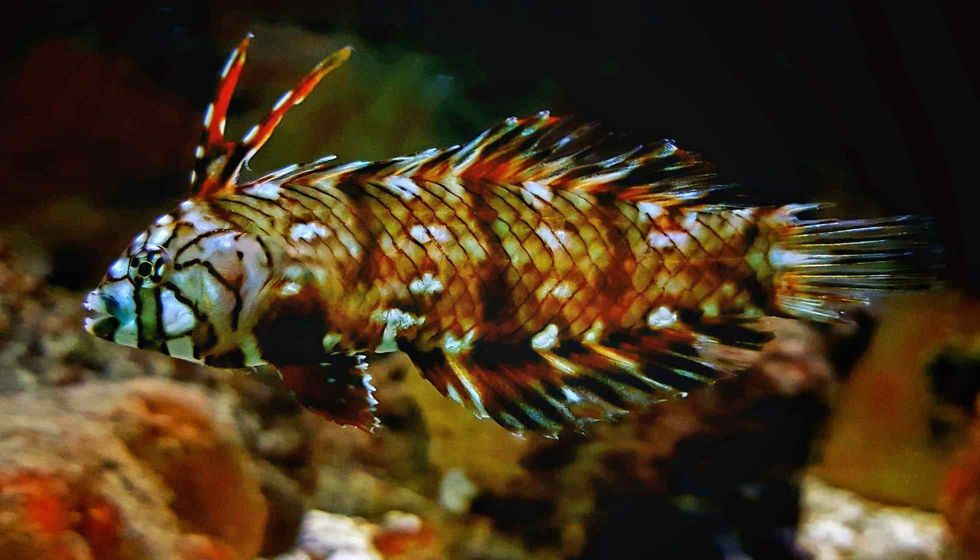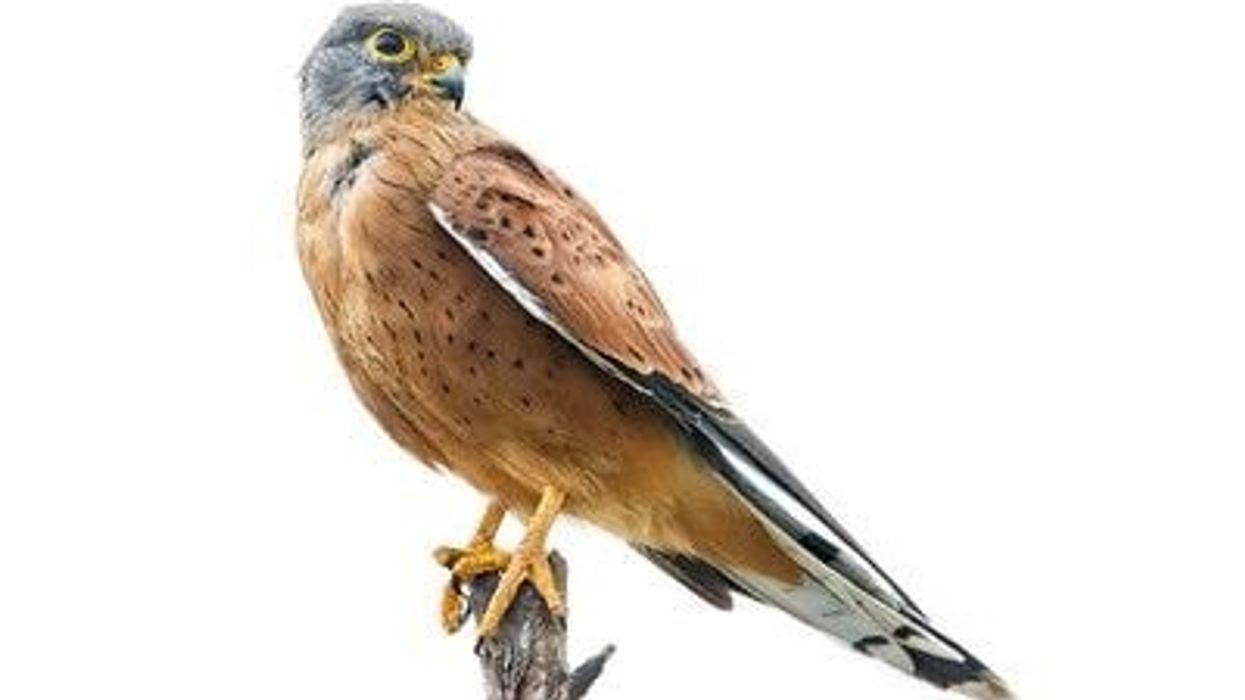The Rockmover Wrasse, Novaculichthys taeniourus, is a wrasse species that has many common names including dragon wrasse, carpet wrasse, olive-scribbled wrasse, reindeer wrasse, and bar-cheeked wrasse. They are named so because of their behavior as well as their appearance.
You must be wondering 'why is it named so?' and 'why does the Rockmover wrasse move rocks?' They were named Rockmover wrasse because they search for prey by shifting rubble and coral fragments.
They do not move rocks, only fragments of rocks. They were named Reindeer and Dragon wrasse due to the first two dorsal-fin spines found in juveniles. The fins in the juvenile Rockmover wrasse are elongated.
The coloration of the juvenile body can range from maroon to green along with white patterns. Adults don't have dorsal spines.
They have a light blue to green-colored body with striking darker patterns. They have black-colored anal and dorsal fins, while the base of their caudal fin is white.
This wrasse species resides in lagoons and coral reefs of the Indo-Pacific region in areas of mixed sand and rubble. They can be found in the Indian and Pacific Oceans at depths of 46–82 ft (14–25 m). Keep reading to get to know more about this mesmerizing fish!
If you like reading about the stunning Rockmove wrasse, then check out our exciting facts about spiny dogfish and codfish.
Rockmover Wrasse Interesting Facts
What type of animal is a Rockmover Wrasse?
The Rockmover Wrasse, Novaculichthys taeniourus, is a fish that is found in semi-exposed reef flats, coral reefs, and lagoons. The Reindeer wrasse belongs to the family Labridae. Their diet comprises snails, crabs, brittle stars, and worms.
What class of animal does a Rockmover Wrasse belong to?
The Rocmover wrasse is a fish belonging to the class Actinopterygii.
How many Rockmover Wrasses are there in the world?
The exact number of Rockmover Wrasse in the world is unknown yet. However, they are not endangered.
Where does a Rockmover Wrasse live?
These spectacular fish can be found across the Indo-Pacific region's (The Indian Ocean and the Pacific Ocean) lagoons and seaward reefs. They are found in Lord Howe Island, Tuamotu, and Japan, and throughout the Red Sea towards Panama.
What is a Rockmover Wrasse's habitat?
The Rockmover Wrasse, Novaculichthys taeniourus, adults reside in shallow reef flats, lagoons, and seaward reefs at depths ranging from 46-82 ft (14-25 m) where there is plenty of sunlight, rubble, and algae growth. They live in areas of mixed rubble as well as sand in the Indo-Pacific region.
They sleep and hide in the sand. Juveniles prefer shallow rubble regions among huge patch reefs. Small wrasses snooze underneath the sand, while bigger wrasses squeeze themselves in cracks.
Who does Rockmover Wrasse live with?
The Rockmover wrasse is a fish that is seen in pairs whereas the juveniles are found alone. They can be put in an aquarium and be housed with bigger fish. Although as a juvenile, it should be kept with more passive species that aren't aggressive.
How long does a Rockmover Wrasse live?
The average lifespan of adults is 3-10 years.
How do they reproduce?
There is not much that is known about this beautiful fish's reproduction process. But we do know that these fish are spotted in pairs frequently and that they are oviparous.
They can change their sex like other wrasses and are pelagic spawners, which means that they disperse their sperm and eggs into the water current. The juveniles prefer to live in areas that are shallow and are on rubble.
What is their conservation status?
This species is not recognized by the IUCN yet. But their population is quite stable in their distribution range.
Rockmover Wrasse Fun Facts
What do Rockmover Wrasses look like?
The juveniles of the dragon wrasse, are eye-catching whereas the adults are elegant. The juveniles' color changes as they grow into an adult. The first two dorsal-fin spines in juveniles are quite long and fall over the head, forming a 'cowlick'.
The elongated rays are gone as the juveniles grow. The body of the adult is dark greenish-brown. They have an elongated white mark on either scale.
Their body is oblong and their head is wedge-shaped and of gray-blue color. There is a vertical row of tiny scales at the back of each eye. There are no scales on the head.
Brown strokes spread from their eyes. There are two black marks in front of the dorsal fin, and a white vertical bar is present at the caudal fin's base. The males and females have a similar appearance with about the same size.

*Please note that this is an image of a Red-tailed Wrasse fish, not a Rockmover Wrasse specifically. If you have an image of a Rockmover Wrasse, then please let us know at hello@kidadl.com
How cute are they?
Their bodies have a variety of colors which makes them look mesmerizing. They look quite cute and their body pattern catches the eye.
How do they communicate?
It is not known how these stunning fish communicate but we do know that they are fiercely protective of their territory. Adults travel over a large region of a reef frequently in pairs. Juveniles do not work in pairs, preferring to accomplish everything alone. When threatened, these wrasses crawl into the sand for safety.
How big is a Rockmover Wrasse?
The Rockmover wrasse is in the range of 11–12 in (27–30 cm) in length. They are half the size of an average Allis shad.
How fast can a Rockmover Wrasse move?
The speed of the wrasse, Novaculichthys taeniourus, is unknown, but they are known to float around in waters of depth ranging between 46-82 ft (14-25 m).
How much does a Rockmover Wrasse weigh?
The weight of the Rockmover wrasse, Novaculichthys taeniourus is unknown. However, these species have an average length of 11 in (27 cm),
What are the male and female names of the species?
The male and female reindeer wrasse have no specific names.
What would you call a baby Rockmover Wrasse?
A baby Rockmover wrasse, dragon wrasse, is called a juvenile.
What do they eat?
They mainly feed on snails, crabs, brittle stars, and worms. If kept as pets, they must be nourished with foods like ghost shrimp, mysid shrimp, flake food, and live black worms. The Red-belly wrasse has protruding teeth.
As its name suggests, large chunks of debris or rubble are shifted by one fish, in search of prey. When the prey is located, it's grabbed by the mouth.
The second fish immediately captures and consumes the prey. Their major predators are sharks, Lionfish, and Barracuda. They hide from them by diving into the sand.
Are they poisonous?
The Red-belly wrasse poses no threat to humans and is not poisonous.
Would they make a good pet?
The Dragon Wrasse, Rockmover Wrasse, or Red-belly Wrasse is easy to keep but can be aggressive. These fish may be rather aggressive at times when new species are introduced into their area, given their territorial nature. Wrasses must be fed frequently.
They will bury themselves in the sand in the aquarium to sleep. This fish loves to swim around, so a 100-gallon aquarium would be required. The aquarium must have a tight cover as this fish can jump out of the tank if it is frightened.
Did you know...
These wrasses can change sex, with most being born as females in the beginning and transitioning to male.
By swaying back and forth in the currents, juveniles mimic algae and resemble the motions of floating seaweed!
There are numerous species of wrasse fish, some of which are reef safe and some of which are not.
Do they bite?
The dragon Rockmover wrasse fish has a tiny mouth but protruding teeth. They can take the bait in their body along with the hook, which makes it impossible to remove.










